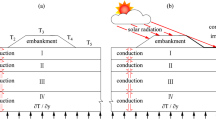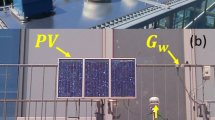Abstract
In order to calculate the air temperature of the near surface layer in urban environment, the surface layer air was divided into several sections in the vertical direction, and some energy balance equations were developed for each air layer, in which the heat exchange due to vertical turbulence and horizontal air flow was taken into account. Then, the vertical temperature distribution of the surface layer air was obtained through the coupled calculation using the energy balance equations of underlying surfaces and building walls. Moreover, the measured air temperatures in a small area (with a horizontal scale of less than 500 m) and a large area (with a horizontal scale of more than 1 000 m) in Guangzhou in summer were used to validate the proposed model. The calculated results accord well with the measured ones, with a maximum relative error of 4.18%. It is thus concluded that the proposed model is a high-accuracy method to theoretically analyze the urban heat island and the thermal environment.
Similar content being viewed by others
References
ZHAO Ming. Dynamics of atmospheric boundary layer [M]. Beijing: Higher Education Press, 2006: 1–2, 26–27. (in Chinese)
SORBJAN Z, ULIASZ M. Some numerical urban boundary-layer studies [J]. Boundary-Layer Meteorology, 1982, 22(4): 481–502.
MILLS G. An urban canopy-layer climate model [J]. Theoretical and Applied Climatology, 1997, 57(3/4): 229–244.
KONDO H, GENCHI Y, KIKEGAWA Y, OHASHI Y, YOSHIKADO H, KOMIYAMA H. Development of a multi-layer urban canopy model for the analysis of energy consumption in a big city: Structure of the urban canopy model and its basic performance [J]. Boundary-Layer Meteorology, 2005, 116(9): 395–421.
KUSAKA H, KONDO H, KIKEGAWA Y, KIMURA F. A simple single-layer urban canopy model for atmospheric models: Comparison with multi-layer and slab models [J]. Boundary-Layer Meteorology, 2001, 101(12): 329–358.
RAN Mao-yu, YANG Ruo-han, MENG Qing-lin. Prediction model and calculation method of the boundary surface temperature of out door space under solar radiation [J]. Acta Energiae Solaris Sinica, 2006, 27(7): 719–724. (in Chinese)
MENG Qing-lin, CHEN Qi-gao, RAN Mao-yu, LI Jian-cheng, CAI Ning. Derivation of the vaporising heat transfer coefficient he [J]. Acta Energiae Solaris Sinica, 1999, 20(2): 216–219. (in Chinese)
XIAO Yong-quan, WANG Fei. Building envelope’s dynamic heat balance model under solar radiation and example analysis [J]. Acta Energiae Solaris Sinica, 2006, 27(3): 270–273. (in Chinese)
ZHANG Lei, MENG Qing-lin, SHU Li-fan. Analysis on dynamic thermal balance model of landscape water and its numerical simulation [J]. Building Science, 2007, 23(10): 58–61. (in Chinese)
HARMAN I N, FINNIGAN J J. A simple unified theory for flow in the canopy and roughness sublayer [J]. Boundary-Layer Meteorol, 2007, 123(5): 339–363.
TANIMOTO Jun, HAGISHIMA A, CHIMKLAI P. An approach for coupled simulation of building thermal effects and urban climatology [J]. Energy and Buildings, 2004, 36: 781–793.
LEE S H, PARK S U. A vegetated urban canopy model for meteorological and environmental modelling [J]. Boundary-Layer Meteorol, 2008, 126(1): 73–102.
ZHANG Qiang, LÜ Shi-hua. The determination of roughness length over city surface [J]. Plateau Meteorology, 2003, 22(1): 24–32. (in Chinese)
HAMLYN D, HILDERMAN T, BRITTER R. A simple network approach to modeling dispersion among large groups of obstacles [J]. Atmospheric Environment, 2007, 41(28): 5848–5862.
GAO Zhi-qiu, BIAN Lin-gen, LU Chang-gui, LU Long-hua, WANG Jin-xing, WANG Ying. Estimation of aerodynamic parameters in urban areas [J]. Quarterly Journal of Applied Meteorlolgy, 2002, 13(1): 26–33. (in Chinese)
Author information
Authors and Affiliations
Corresponding author
Additional information
Foundation item: Project(50808083) supported by the National Natural Science Foundation of China
Rights and permissions
About this article
Cite this article
Zhang, L., Meng, Ql. Near ground air temperature calculation model based on heat transfer of vertical turbulent and horizontal air flow. J. Cent. South Univ. Technol. 19, 721–726 (2012). https://doi.org/10.1007/s11771-012-1063-9
Received:
Accepted:
Published:
Issue Date:
DOI: https://doi.org/10.1007/s11771-012-1063-9




